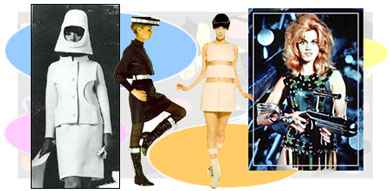Space Age style

Fashion Synopsis
The U.S. was jettisoned into the lead of the Space Race when, on July 20, 1969, the first astronauts to walk the moon were America’s very own Neil Armstrong and Edwin ‘Buzz’ Aldrin. The allure of outer space has inspired fashion since the dawn of man’s understanding of the world beyond, but it wasn’t until the technological advances of the 60’s that space travel became a reality.
In these heady times, fashion reflected the new streamlined sleekness of technology. The 60’s designers were experimental, and technologically advanced materials were used for a fantastical flight into the future. Bored with traditional fabrics, designers looked to other materials for inspiration: metal, plastic, paper, and new polymer fabrics like vinyl.
American astronaut John Glenn orbited the Earth in 1962, and Major Ed White performed the first spacewalk in 1965. These amazing feats inspired designer Pierre Cardin, who released a Cosmos collection in 1965. His line featured geometric-cut tunics worn over body stockings and tights, worn with bubble hats and cut-away helmets. Cardin propelled the body-conscious fit that would influence space age style for years to come.
Andre Courreges, the quintessential space age designer, turned futuristic when he created go-go boots and vinyl cutouts on clothes. His lines were sleek, sharp and geometric, and his materials combined in unique and exceptional ways. He juxtaposed clashing colors that seemed to work when done in stark lines and trims on a base of white. He practiced architecture and engineering in his clothes, and even created Cosmonaut costumes for daily wear.
Paco Rabanne turned out brilliant masterpieces from metallic discs that were pliers instead of a sewing machine. Diane Dew put her electrical engineering degree to work, creating electrical light clothes that could be switched off and on for your own neon lightshow.
Betsey Johnson, queen of anti-fashion fashion, created the ultimate in swinging style with entire wardrobes constructed out of unorthodox materials. Michele Rosier was dubbed the ‘vinyl girl,’ making entire wardrobes from the indestructible, cheap, space age styling of vinyl. The wave of the future, vinyl was true wear and wash: a little Windex and a paper towel was all that was needed to clean the slick and waterproof surface.
Futuristic fashion came to a bitter end when the Vietnam War delivered death to America’s front door. With half of the young men drafted, the future looked bleak, and no longer inspired hope.
